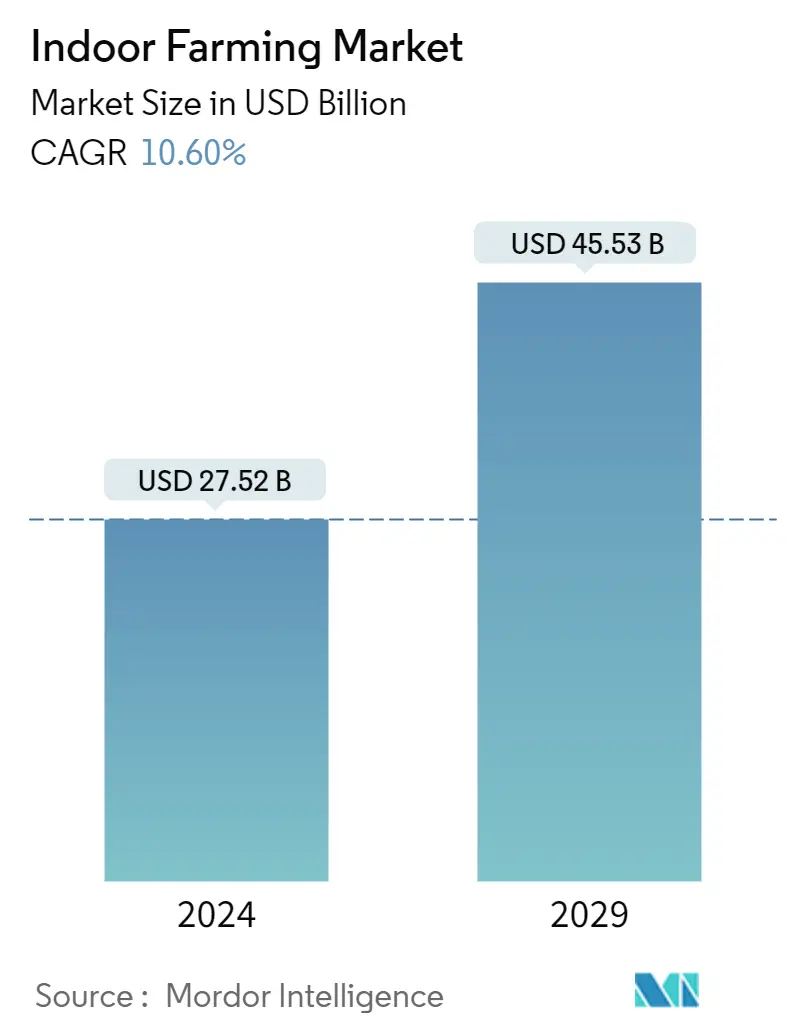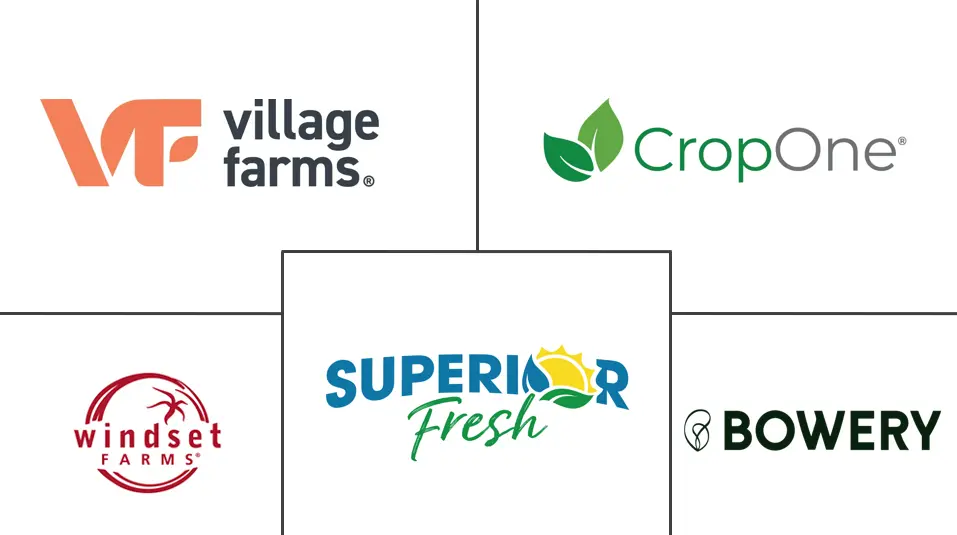Market Size of Indoor Farming Industry

| Study Period | 2019 - 2029 |
| Market Size (2024) | USD 27.52 Billion |
| Market Size (2029) | USD 45.53 Billion |
| CAGR (2024 - 2029) | 10.60 % |
| Fastest Growing Market | Asia-Pacific |
| Largest Market | North America |
| Market Concentration | Low |
Major Players
*Disclaimer: Major Players sorted in no particular order |
Indoor Farming Market Analysis
The Indoor Farming Market size is estimated at USD 27.52 billion in 2024, and is expected to reach USD 45.53 billion by 2029, growing at a CAGR of 10.60% during the forecast period (2024-2029).
- An increase in health consciousness and consumption of residue-free food has paved the way for the usage of advanced techniques, like indoor farming. People are growing the necessary crops in their own houses on a small scale to have food free from pests, resulting in a higher yield.
- Among the various growing types, soil-based indoor farming dominates the market. Its ability to enhance the harvesting cycle of plants, when compared to traditional farming, is driving its market growth. By facility type, glass or poly greenhouses occupy a larger market share, while the indoor deep-water culture system is anticipated to witness the highest CAGR during the forecast period. There is an increase in the demand for sustainable food production in the Middle East, which is achievable by adopting indoor vertical farming technologies in agriculture.
- North America accounted for the largest market share in 2021. The US is a major contributor to the region's share, followed by Canada and Mexico. One of the primary reasons indoor farming has been gaining significant traction is because of its ability to produce more with fewer resources. For example, as per the US Department of Agriculture (USDA), the average yield of conventional lettuce farming doubled twofold when cultivated through vertical farming. The indoor farming market in the Asia-Pacific region is growing rapidly, with the industry benefiting from government policies.
Indoor Farming Industry Segmentation
Indoor farming is a method of growing crops or plants entirely indoors, usually on a large scale.
The indoor farming market is segmented by the growing system (aeroponics, hydroponics, aquaponics, soil-based, and hybrid), facility type (glass or poly greenhouses, indoor vertical farms, container farms, indoor deep water culture systems, and other facility types), crop type (fruits and vegetables, herbs and microgreens, flowers and ornamentals, and other crop types), and geography (North America, Europe, Asia-Pacific, South America, and Africa). The report offers market size and forecasts in terms of value in USD million for the abovementioned segments.
| Growing System | |
| Aeroponics | |
| Hydroponics | |
| Aquaponics | |
| Soil-based | |
| Hybrid |
| Facility Type | |
| Glass or Poly Greenhouses | |
| Indoor Vertical Farms | |
| Container Farms | |
| Indoor Deep Water Culture Systems | |
| Other Facility Types |
| Crop Type | ||||||||||||
| ||||||||||||
| ||||||||||||
| ||||||||||||
| Other Crop Types |
| Geography | |||||||||
| |||||||||
| |||||||||
| |||||||||
| |||||||||
|
Indoor Farming Market Size Summary
The indoor farming industry is experiencing significant growth, driven by increasing health consciousness and the demand for residue-free food. This sector utilizes advanced agricultural techniques to produce crops in controlled environments, such as soil-based systems and greenhouses, which enhance yield and reduce resource consumption. The market is expanding globally, with North America leading due to its adoption of high-efficiency technologies and urban farming practices. The Asia-Pacific region is also witnessing rapid growth, supported by favorable government policies. The decline in arable land and rising pollution in developing regions, particularly in South Asia, are further propelling the demand for indoor farming as a sustainable alternative to traditional agriculture.
The market landscape is highly fragmented, with numerous small companies alongside major players like Village Farms International Inc. and Bowery Inc. These companies are investing in innovative technologies and partnerships to enhance productivity and expand their market presence. The adoption of hydroponics and aeroponics systems is particularly notable in North America, where the focus on organic and pesticide-free produce is driving demand. The industry's growth is also supported by the need to increase food production in areas with limited arable land, such as Mexico and China, where urbanization and soil degradation are significant challenges. As the global population continues to rise, indoor farming is poised to play a crucial role in meeting food security demands while minimizing environmental impact.
Indoor Farming Market Size - Table of Contents
-
1. MARKET DYNAMICS
-
1.1 Market Overview
-
1.2 Market Drivers
-
1.3 Market Restraints
-
1.4 Porter's Five Forces Analysis
-
1.4.1 Threat of New Entrants
-
1.4.2 Bargaining Power of Buyers/Consumers
-
1.4.3 Bargaining Power of Suppliers
-
1.4.4 Threat of Substitute Products
-
1.4.5 Intensity of Competitive Rivalry
-
-
-
2. MARKET SEGMENTATION
-
2.1 Growing System
-
2.1.1 Aeroponics
-
2.1.2 Hydroponics
-
2.1.3 Aquaponics
-
2.1.4 Soil-based
-
2.1.5 Hybrid
-
-
2.2 Facility Type
-
2.2.1 Glass or Poly Greenhouses
-
2.2.2 Indoor Vertical Farms
-
2.2.3 Container Farms
-
2.2.4 Indoor Deep Water Culture Systems
-
2.2.5 Other Facility Types
-
-
2.3 Crop Type
-
2.3.1 Fruits and Vegetables
-
2.3.1.1 Leafy Vegetables
-
2.3.1.1.1 Lettuce
-
2.3.1.1.2 Kale
-
2.3.1.1.3 Spinach
-
2.3.1.1.4 Other Leafy Vegetables
-
-
2.3.1.2 Tomato
-
2.3.1.3 Strawberry
-
2.3.1.4 Eggplant
-
2.3.1.5 Other Fruits and Vegetables
-
-
2.3.2 Herbs and Microgreens
-
2.3.2.1 Basil
-
2.3.2.2 Herbs
-
2.3.2.3 Tarragon
-
2.3.2.4 Wheatgrass
-
2.3.2.5 Other Herbs and Microgreens
-
-
2.3.3 Flowers and Ornamentals
-
2.3.3.1 Perennials
-
2.3.3.2 Annuals
-
2.3.3.3 Ornamentals
-
2.3.3.4 Other Flowers and Ornamentals
-
-
2.3.4 Other Crop Types
-
-
2.4 Geography
-
2.4.1 North America
-
2.4.1.1 US
-
2.4.1.2 Canada
-
2.4.1.3 Mexico
-
2.4.1.4 Rest of North America
-
-
2.4.2 Europe
-
2.4.2.1 Germany
-
2.4.2.2 UK
-
2.4.2.3 France
-
2.4.2.4 Russia
-
2.4.2.5 Spain
-
2.4.2.6 Italy
-
2.4.2.7 Rest of Europe
-
-
2.4.3 Asia-Pacific
-
2.4.3.1 China
-
2.4.3.2 Japan
-
2.4.3.3 India
-
2.4.3.4 Australia
-
2.4.3.5 Singapore
-
2.4.3.6 South Korea
-
2.4.3.7 Rest of Asia-Pacific
-
-
2.4.4 South America
-
2.4.4.1 Brazil
-
2.4.4.2 Argentina
-
2.4.4.3 Rest of South America
-
-
2.4.5 Africa
-
2.4.5.1 South Africa
-
2.4.5.2 Rest of Africa
-
-
-
Indoor Farming Market Size FAQs
How big is the Indoor Farming Market?
The Indoor Farming Market size is expected to reach USD 27.52 billion in 2024 and grow at a CAGR of 10.60% to reach USD 45.53 billion by 2029.
What is the current Indoor Farming Market size?
In 2024, the Indoor Farming Market size is expected to reach USD 27.52 billion.

